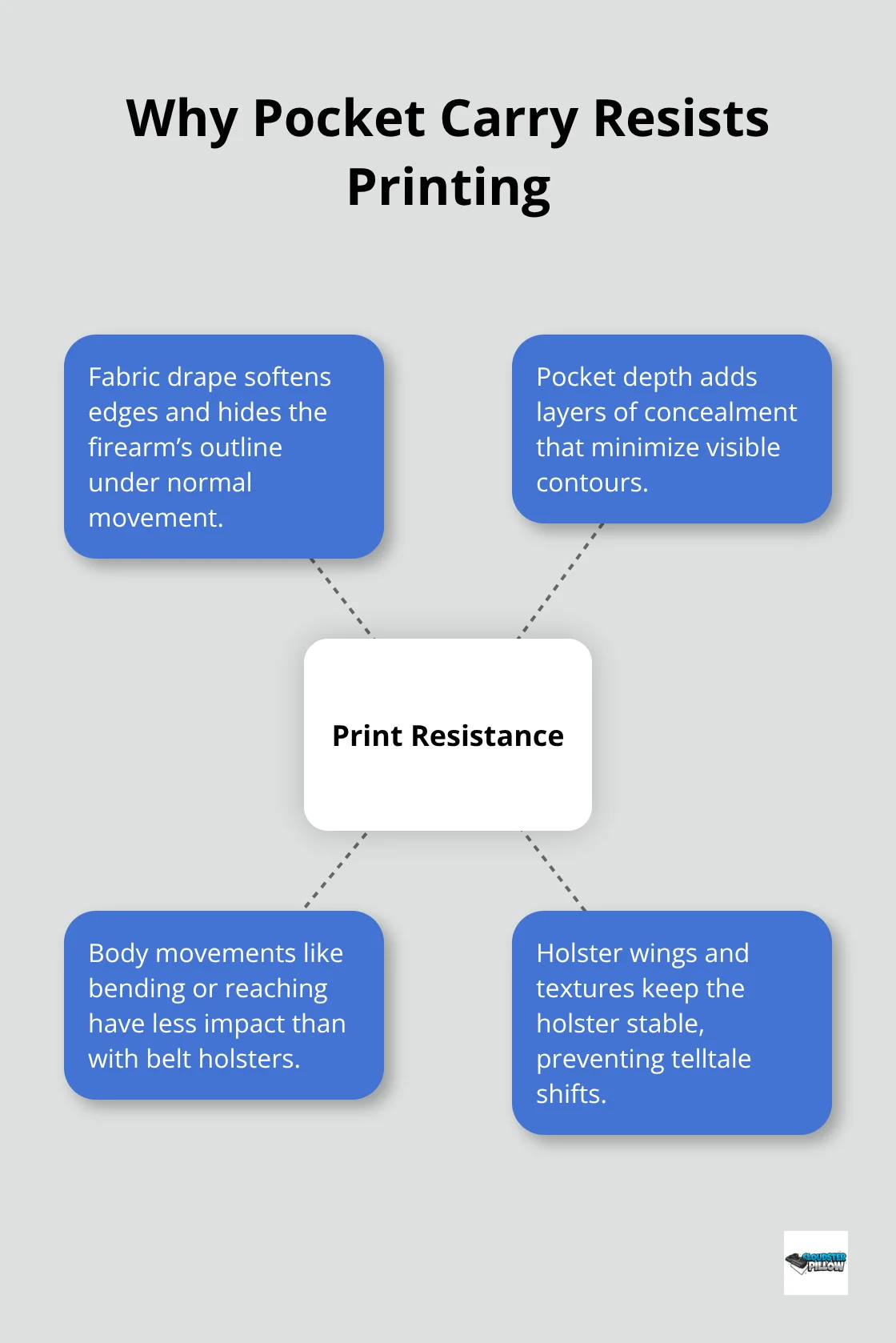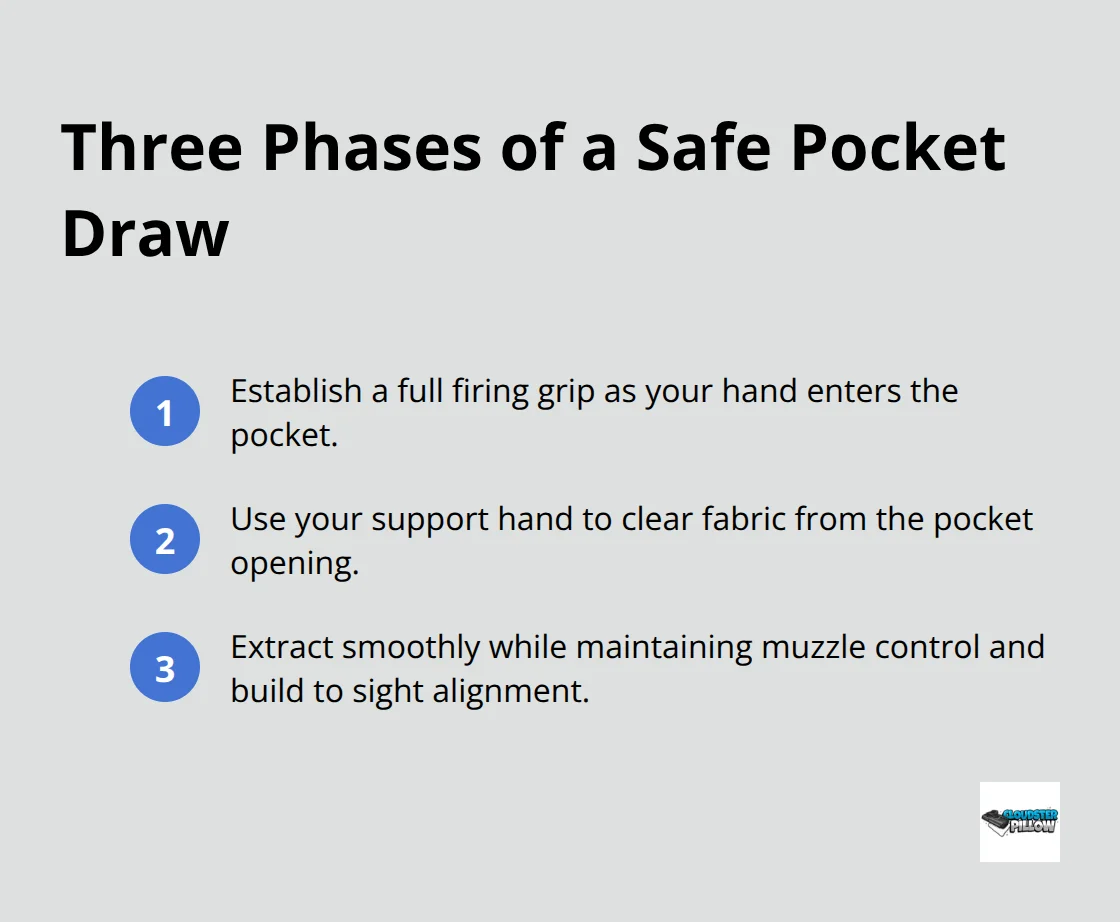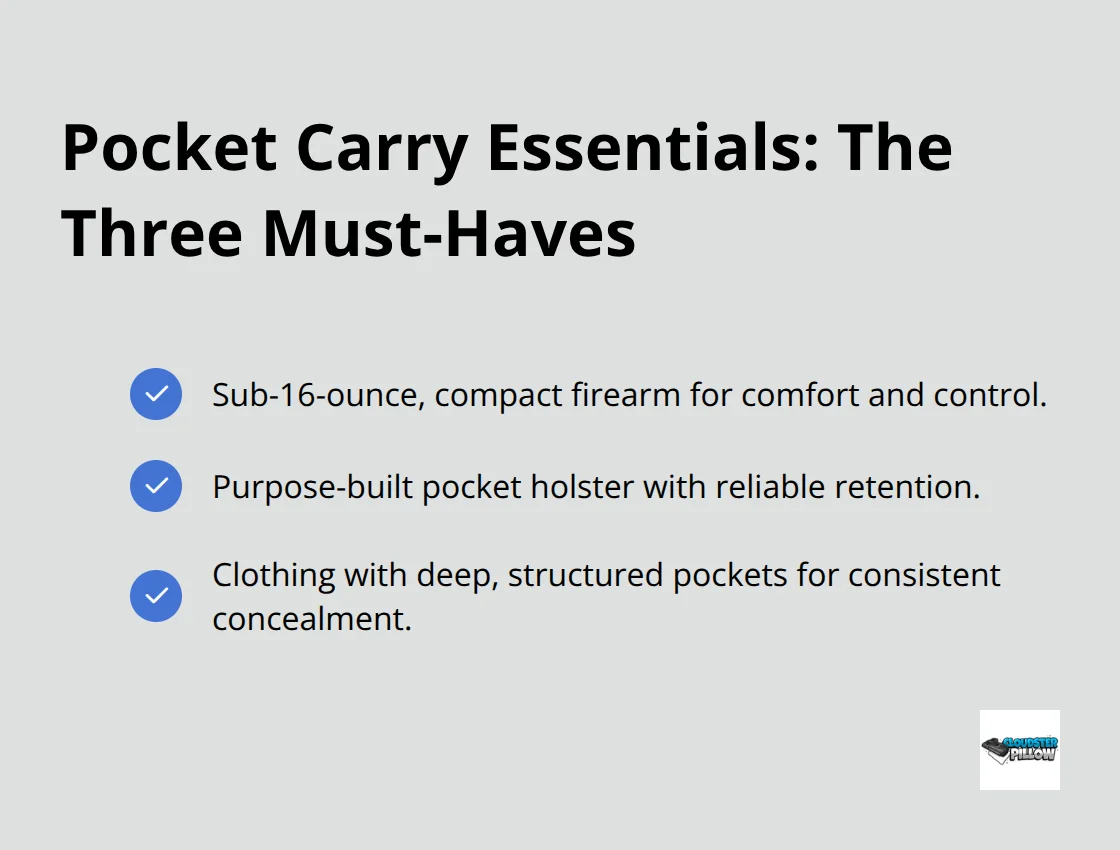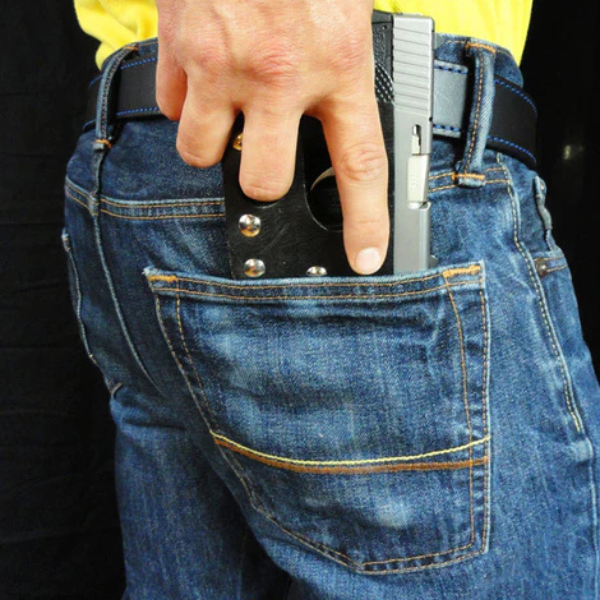Holsters and Gear Recommendations
Why Pocket Carry Might Be Your Best Concealed Carry Option

We at Cloudster Pillow believe pocket carry offers unique advantages that traditional holster methods simply can’t match. When done correctly, it provides superior concealment and comfort for everyday carry situations.
What Makes Pocket Carry So Effective
Natural Hand Movement Creates Tactical Advantage
Pocket carry transforms your natural hand movement into a tactical advantage. Your hands naturally move toward your pockets dozens of times daily, which makes firearm access completely inconspicuous. The National Institute of Justice research shows that concealed carriers prefer positions that allow easy reach and discretion, with pocket carry scoring highest for subtlety. This method allows you to maintain a grip while your hand remains in your pocket, which gives you precious seconds to assess threats without telegraph your intentions. Traditional holster positions require obvious reach movements that alert potential attackers.
Clothing Compatibility Beats Traditional Methods
Standard holsters fail with casual attire, but pocket carry excels across all wardrobe choices. Athletic wear, business casual, and formal attire accommodate pocket firearms without modification. FBI crime statistics indicate compact firearm sales have increased recently, driven largely by pocket carry adoption. Your attire naturally conceals the firearm outline, while quality pocket holsters with rough textures or concealment flaps eliminate print entirely.
The Desantis Superfly incorporates flaps that disguise gun shapes completely, which makes detection nearly impossible. Traditional belt holsters create bulges and require specific cuts, which limits your wardrobe options significantly. Pocket carry works with jeans, slacks, shorts, and jackets without compromise to concealment effectiveness.
Superior Print Resistance Across Body Types
Pocket carry eliminates the print issues that plague traditional holster methods. The fabric naturally drapes over the firearm, while your pocket’s depth creates additional concealment layers. Research from the National Shooting Sports Foundation shows that over 60% of gun owners consider pocket carry a viable option specifically because it reduces visible outline (particularly important for professional environments). Your body movement doesn’t affect concealment like it does with belt holsters, where bends and reaches expose the firearm outline.

Quality pocket holsters feature wings and textures that keep them secure during movement and quick draws. This stability prevents the telltale shift that compromises other carry methods when you move through daily activities.
What Makes the Perfect Pocket Carry Setup
Firearm Requirements That Actually Matter
The average pocket pistol weighs approximately 15 ounces, but weight alone doesn’t determine effectiveness. Compact handguns are easier to carry and conceal, with pocket-size firearms representing the smallest category available. The Glock 43X exemplifies ideal proportions, while larger models create uncomfortable bulges that compromise concealment. Barrel length should stay between 2.5 to 3.5 inches for optimal balance between concealability and accuracy. Most pocket firearms maintain effective ranges of 7 to 15 yards, which covers the vast majority of self-defense scenarios according to statistics showing guns are used in 1,800,000 self-defense incidents annually.
Essential Holster Features for Success
Quality pocket holsters must feature rough exterior textures that grip fabric and prevent the holster from following the gun during draw. The Safariland Model 25 uses suede lining that stays sweatproof while it enables smooth draws, while the Vedder Holsters Pocket Locker emphasizes kydex construction for superior retention. Concealment flaps are non-negotiable features that disguise firearm shapes completely. The Desantis Pocket Partner utilizes polymer construction specifically designed to break up gun outlines. Retention adjustment capabilities allow customization for different firearms (with the Alien Gear ShapeShift offering this versatility across multiple gun models).
Common Mistakes That Ruin Effectiveness
Generic fabric pouches instead of purpose-built holsters create dangerous trigger exposure and poor retention. The National Institute of Justice provides ongoing development efforts for duty holster retention standards, emphasizing that proper holsters prevent accidental discharges by covering triggers completely. Pockets without holsters become potential safety hazards. Oversized holsters create unnecessary bulk while undersized options fail to protect triggers adequately. Many carriers select holsters based on price rather than fit, which compromises both safety and draw efficiency. Kramer Leather demonstrates how proper craftsmanship affects both comfort and functionality (making holster quality a vital investment rather than an afterthought).
The foundation of effective pocket carry extends beyond equipment selection. Your technique and daily practices determine whether your setup succeeds or fails when you need it most.
How to Master Safe Pocket Carry
Draw Technique Fundamentals That Work
The pocket draw requires specific techniques that differ completely from traditional holster methods. Your support hand must clear the pocket opening by pulling fabric away from your strong side, while your shooting hand maintains a full firing grip inside the pocket. Law enforcement officers carry backup guns on duty and prefer pocket-sized firearms as backup weapons specifically because the draw motion appears natural and non-threatening.
Practice the draw in three distinct phases: grip establishment while hand enters pocket, fabric clearance with support hand, and smooth extraction with muzzle control. The USCCA emphasizes that regular practice develops muscle memory essential for high-pressure situations. Your draw should take 2.5 to 3 seconds from pocket entry to sight alignment, with consistent practice reducing this time significantly.

Clothing Selection That Actually Matters
Loose-fitting pants with deep pockets create optimal concealment conditions, while tight clothing compromises both access and concealment effectiveness. Cargo pants and relaxed-fit jeans provide the best pocket depth and fabric drape for concealment. Carriers who select appropriate clothing report better concealment satisfaction compared to those who compromise on fit.
Front pockets work better than rear pockets because they allow natural hand positioning and faster access during seated positions. Avoid stretch fabrics that conform to firearm shapes, and select materials with enough weight to drape properly over your pocket holster. Jackets with side pockets offer excellent concealment but require practice for smooth draws (while blazers and sport coats provide professional appearance with tactical capability).
Safety Protocols That Prevent Accidents
Pocket carry demands absolute trigger discipline because your hand enters an enclosed space with limited visibility. Never place anything else in your firearm pocket – keys, coins, or phones create dangerous trigger snag potential that could cause accidental discharge. Proper holsters prevent accidental discharges by completely covering trigger guards.
Check your holster daily for wear, debris, or damage that could compromise trigger protection. Practice drawing with an unloaded firearm until your technique becomes automatic, then progress to live fire training at ranges that permit holster work. Keep your trigger finger straight along the frame until you achieve sight alignment and target identification (maintaining this discipline prevents negligent discharges during high-stress situations). For those new to concealed carry, understanding these fundamentals is crucial for safe and effective pocket carry.
Final Thoughts
Pocket carry works best for professionals who need maximum discretion, urban dwellers who wear business attire, and anyone who prioritizes comfort over firepower. The method excels when your lifestyle demands deep concealment without wardrobe restrictions. Critics often cite slower draw times and limited firepower as dealbreakers, but statistics show most self-defense encounters occur within 7 yards, well within pocket pistol capabilities.
Your pocket carry setup requires three components: a quality firearm under 16 ounces, a purpose-built holster with retention features, and appropriate clothes with deep pockets. Start with established models like the Glock 43X paired with holsters from Safariland or Desantis. Practice your draw technique daily with an unloaded firearm until muscle memory develops (the 2.5-second draw time proves adequate for real-world scenarios where concealment matters more than speed).

Some carriers prefer appendix carry for faster access over pocket carry methods. We at Cloudster Pillow understand that different carry methods suit different needs. Our holster wedge collection helps optimize appendix and IWB setups by eliminating print and improving comfort for those who choose traditional holster methods.

